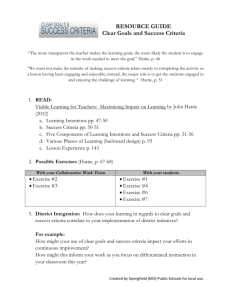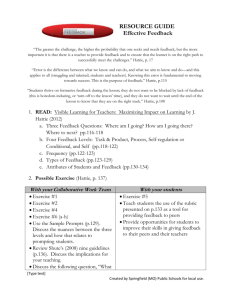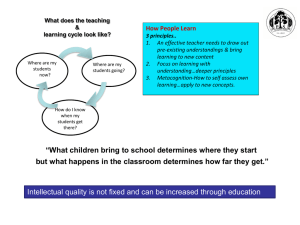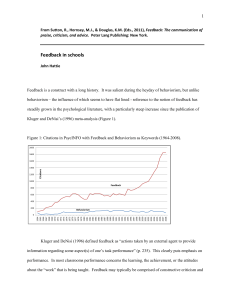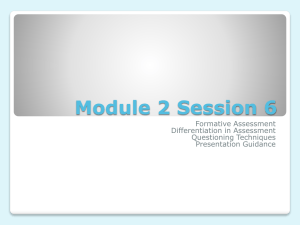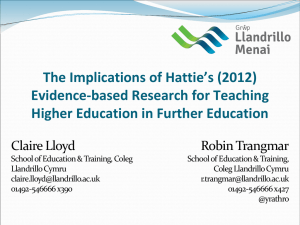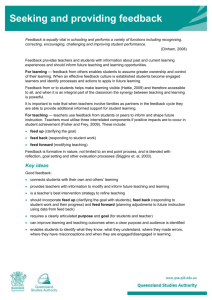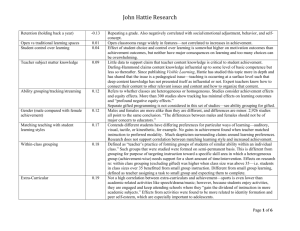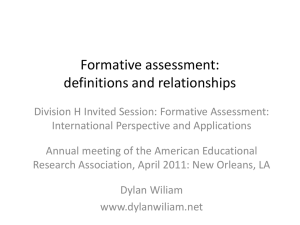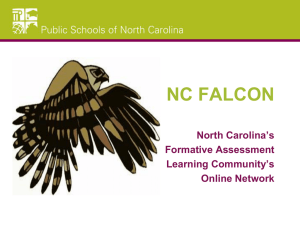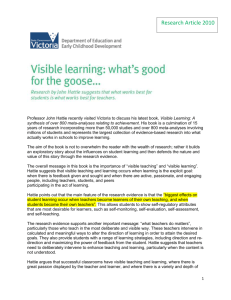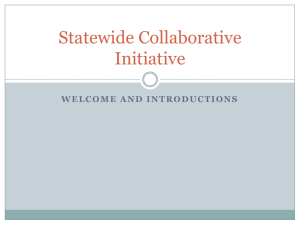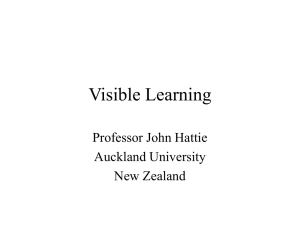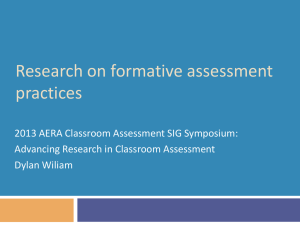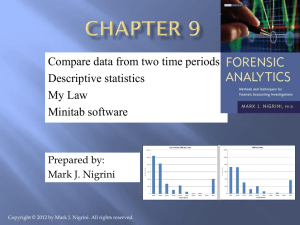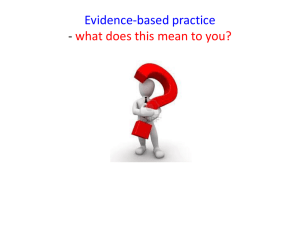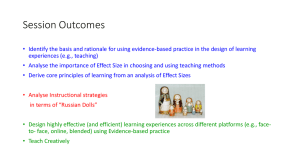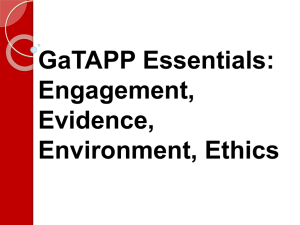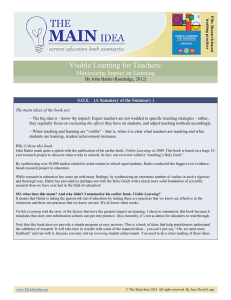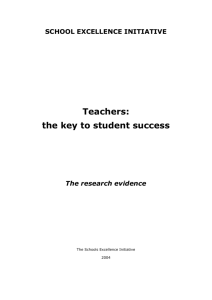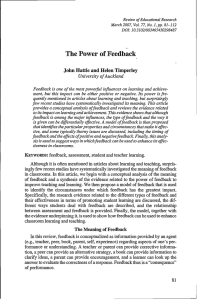The Power of Purposeful Feedback
advertisement
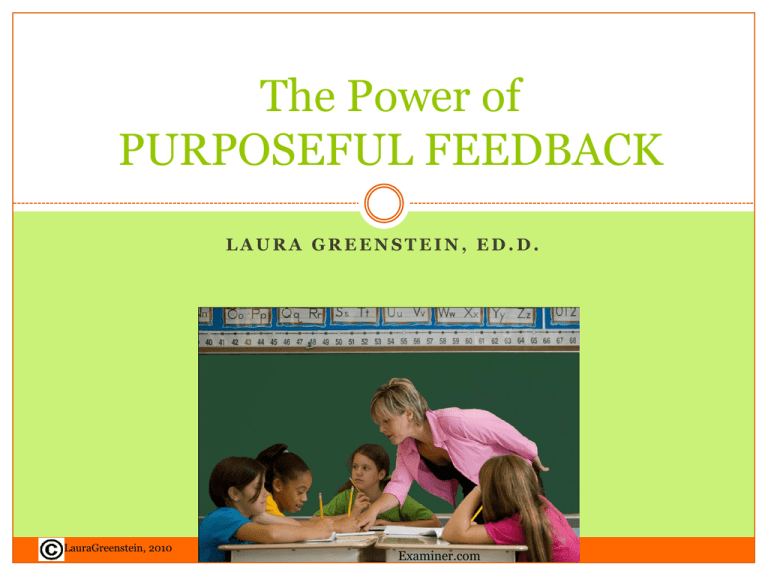
The Power of PURPOSEFUL FEEDBACK LAURA GREENSTEIN, ED.D. LauraGreenstein, 2010 Examiner.com TODAY’S GOALS Explore the research on the purpose and value of feedback Identify quality indicators of effective feedback Utilize feedback to inform and guide teaching and learning Q & A: What Are Yours? THE TRUE VALUE OF FEEDBACK Ruth Butler (1986) Students given only comments scored on average 30% higher. (Grades resulted in no gain, grades and comments cancelled the beneficial effects of comments.) Robert Marzano (2001) Providing feedback yields a 23 percentile gain John Hattie (2009) Feedback has an effect size of 1.13. The equivalent of one standard deviation Others: Susan Brookhart, Shirley Clarke, Helen Temperley, Dylan Wiliam, Anne Davies, Carol Dweck, Avraham Kluger and Angelo Denisi THE FEEDBACK EXPERIENCE You call this lunch! tvguide.com Q & A: What comes to mind when you hear the word “FEEDBACK” FEEDBACK LOOP FEED UP: Where am I going; What’s the target; exemplars? FEEDBACK: How am I doing; descriptive, reflective? FEED Forward: What’s the next step(s)? clickaclass.com Medals and Missions: Feedback Evaluative Feedback Descriptive Feedback Focused on Targets: Judgment: •Accurate work in discussing the A+ work main points. What can you now expand on? Try harder next •Your hypothesis is a useful time proposal. How can you rewrite it as an if…then…statement? Good essay •Process was correctly followed Emerging skills but you made a simple mathematical error in step 2. Remember to check your work. THE FOCI OF FEEDBACK Types of Feedback: (Hattie and Timperley, 2007) Task/Performance Process Self-regulation In the Context of Timing Best Practice Target Audience douglas.co.us TASK/PERFORMANCE Explain your chart I agree with your data, but consider alternative conclusions also. PROCESS underwhelmedcomic.com Character needs development Describe what your character looked like and the way his clothes hung from his body SELF REGULATION and DIRECTION Developing Next Steps http://assessment.tki.org.nz Tundra.com IT’S ALL IN THE TIMING Wordpress.com FEEDBACK TIMING Immediately in response to a question Immediately to student misconceptions Sooner for process, slight delay is okay for task Longer assignments: within 2 days with a review Expectancy of feedback raises achievement BEST PRACTICE Specific Understandable Best Practice Actionable Descriptive SPECIFIC Adequate amount and detail: For the target To the student Incorrect strategy Awesome graphing but remember to label your axes. DESCRIPTIVE About the Task Process Self-regulation Nice opening sentence Your opening sentence grabbed the reader with descriptive detail and introduced the mystery to be solved. ACTIONABLE Explains: What to do How to do it It looks like you worked hard on your poster but it needs more detail You have a good start with your review of the main ideas in the center of your poster. It would help to use the side panels to provide supporting evidence. UNDERSTANDABLE Can be acted upon Specific Clear Good presentation skills Cartoon Removed You engaged the listeners through your questioning strategy. Remember also, to make eye contact with your audience. SORTING Thru FEEDBACK Put the # of each example in the more or less effective column 1. Feedback 2 weeks after the end of the unit. (example is below) 2.Rearrange your sentences in this sequence…then add more detail to each one. 3. B+ 4. I know you can do better with more effort 5. Your data is correct but these 2… are in the wrong category 6. Accurate content in your presentation. Next time think of ways to engage your audience perhaps with… MORE EFFECTIVE LESS EFFECTIVE 1 SORTING Thru FEEDBACK Put each example in the more or less effective column 1. Feedback 2 weeks after the end of the unit. 2.Rearrange your sentences in this sequence…then add more detail to each one. 3. B+ 4. I know you can do better with more effort 5. Your data is correct but these 2… are in the wrong category 6. Accurate content in your presentation. Next time think of ways to engage your audience perhaps with… MORE EFFECTIVE LESS EFFECTIVE 2 1 5 3 6 4 Q & A: Now You Try It- Respond to this 5th grade history essay with one feedback statement. •Pick one focus •Respond to content or style •Post 1 statement Essay removed. Please respond to your own chosen student work. EMERGING RESEARCH Questions yet to be answered: Is it more effective In certain subject areas? At certain grade levels? With students from different backgrounds? For students with different aptitudes? With fixed vs. growth mindset? From teacher, self, or peers? LOGICAL CONCLUSIONS How it is used to improve and guide teaching and learning is primary. Reasonable Recommendations Use feedback as part of a spectrum of strategies Use feedback selectively based on students and setting Use feedback responsively to inform instruction TAKE-AWAYS The mistake I was making was seeing feedback as something teachers provided to students… it was only when I discovered when it is from the student to the teacher that I started to understand it better. (Hattie, p. 173) Please leave behind: Two stars (what will take away?) and one wish (what else do you need?) CONTACT INFORMATION Laura Greenstein lauragteacher@hotmail.com http://www.assessmentnetwork.net What Teachers Really Need to Know About Formative Assessment http://shop.ascd.org/productdisplay. cfm?productid=110017 REFERENCES Brookhart, Susan (2008). How to Give Effective Feedback to Your Students. Alexandria, VA: Association for Supervision and Curriculum Development. Butler, Ruth & Nisan, Mordecai (1986) Effects of No Feedback, Task-Related Comments, and Grades on Intrinsic Motivation and Performance. Journal of Educational Psychology 78 (3) pp. 210-216. Clarke, Shirley (2003). Enriching Feedback in the Primary Classroom. London: Hodder and Stoughton. Davies, Anne (2010). Making Classroom Assessment Work (2nd Ed.) Connections Hattie, John & Timperley, Helen (2007). The Power of Feedback. Review of Educational Research. 77, pp. 81-112. http://www.eric.ed.gov/ERICWebPortal/search/detailmini.jsp?_nfpb=true&_&E RICExtSearch_SearchValue_0=EJ782448&ERICExtSearch_SearchType_0=no&acc no=EJ782448 MORE REFERENCES Hattie, John (2009). Visible Learning: A Synthesis of over 800 meta-analyses relating to achievement. England: Routledge http://books.google.com/books?hl=en&lr=&id=lh7SZNCabGQC&oi=fnd&pg=PP1&ots= dibQRMWbZG&sig=vqVQFaWbH-d0BNsqV17HwgaUGG0#v=onepage&q&f=false Hawk, Kay & Hill, Jan (2001). The Challenge of Formative Assessment in Secondary Classrooms SPANZ Journal Kluger, Avraham, & DeNisi, Angelo. (1996). The Effects of Feedback Interventions on Performance: A Historical Review, a Meta-Analysis, and a Preliminary Feedback Intervention Theory. Psychological Bulletin: 119 (2) pp 254-284. http://www.tamu.edu/classes/payne/PA/Kluger%20&%20DeNisi%201996.pdf Marzano, Robert, Pickering, Debra, & Pollock, Jane (2001). Classroom Instruction That Works: Research-Based Strategies for Improving Student Achievement. Alexandria, VA: Association for Supervision and Curriculum Development. Sadler, Royce (1989). Formative Assessment and the Design of Instructional Systems. Instructional Science, 18, 119–44. Tunstall, Pat & Gipps, Caroline (1996). Teacher Feedback to Young Children in Formative Assessment: A Typology. British Educational Research Journal, 22 (4).
